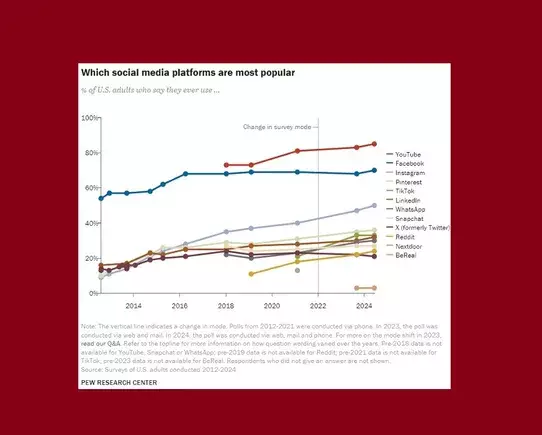In a rapidly evolving digital landscape, the nuances of social media usage among U.S. adults are gaining increasing scrutiny. According to the recent survey conducted by Pew Research, which involved over 5,600 participants from February to June of this year, certain trends have captured attention, specifically regarding the relevance of popular platforms. A notable takeaway is the continued dominance of YouTube as the leading social media application, even as its classification as a “social” platform is open to interpretation. Amidst a plethora of platforms, Facebook and Instagram still claim substantial user bases, while emerging competitors vie for attention.
Yet, is the platform formerly known as Twitter, now branded as X, diminishing in significance? Pew’s findings suggest a nuanced decline rather than a stark drop-off, indicating that while there are whispers of its waning influence, it remains in the conversation. Social media, particularly platforms such as YouTube, Facebook, and Instagram, showcases both stability and a degree of flux in user preferences that are critical for understanding contemporary online engagement.
Delving deeper into the data presented by Pew Research, the findings reveal that YouTube and Facebook have become the cornerstones of online social engagement. Approximately half of the adults surveyed acknowledged their use of Instagram, which still holds a pivotal place in the social media hierarchy. In contrast, platforms like TikTok, LinkedIn, and Snapchat command smaller but significant shares of the market.
Despite TikTok’s explosive growth in previous years, recent statistics reveal that its user base has plateaued, showing no substantial increase in engagement over the past year. Oddly enough, applications like Pinterest have experienced slight upticks, suggesting shifting interests among digital consumers. Notably, LinkedIn, WhatsApp, and Reddit have all seen mild growth, while Snapchat’s user engagement has maintained stability.
What stands out in this analysis is the divergence in platform usage across demographic lines. As Facebook continues to resonate predominantly with older generations, TikTok and Snapchat are capturing the youthful demographic through robust engagement features. However, YouTube transcends these age barriers, drawing in a diverse audience eager for visual content.
When discussing the implications of these findings, one cannot overlook YouTube’s unique positioning. Though primarily a video-sharing site, its engagement hinges less on interaction and more on consumption. This challenges traditional views about what constitutes a “social” platform. Similarities with TikTok are apparent, but many argue that TikTok’s design is inherently more social, allowing users to engage directly with their peers.
Interestingly, this raises an important discourse on the evolution of social media itself. Are platforms that prioritize content consumption more valuable than those fostering interaction? With YouTube’s established user base, it becomes important to consider its role in shaping social media strategies moving forward, particularly as the younger audience shows proclivity towards content that encapsulates instant entertainment.
As digital marketers and strategists contemplate their 2025 strategies, understanding these trends is crucial. The data implies that a careful segmentation of audience preferences by age and platform type can yield effective strategies tailored to each demographic. With identifiable trends indicating that TikTok and Snapchat resonate with younger audiences, while Facebook serves older users, brands need to adapt their messaging accordingly.
As we’ve seen, while X may not be plunging into oblivion, its relevance is fraught with uncertainty. Similarly, platforms like BeReal, which emerged with significant buzz, now appear to be waning, serving as a reminder of the fickle nature of social media trends. This unpredictability underscores the necessity for flexibility in strategic planning.
While YouTube, Facebook, and Instagram retain their reign over U.S. adults, the emergence of alternative platforms and shifting engagement patterns signal a transformative era in social media. Recognizing these evolving trends will be essential for brands and marketers seeking to solidify their presence in today’s dynamic digital landscape.


Leave a Reply